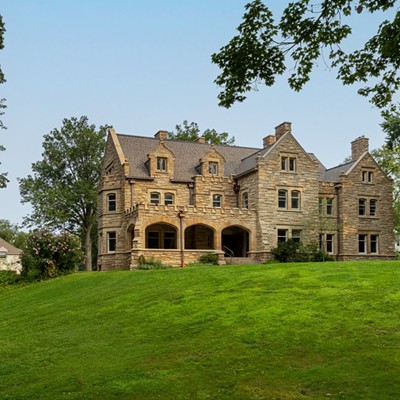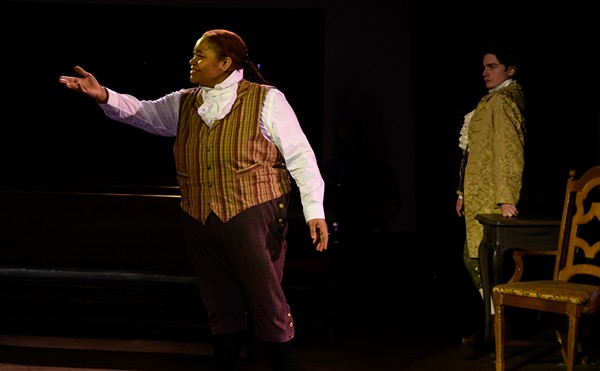Busy -- Consumerism is the ostensible theme of these mixed-media images by California artist Nathan Haenlein. But that rationale seems forced; in the end, they're simply objects of great luster, depth, and visual complexity. The formula behind them is consistent, which isn't to say that they're formulaic. Haenlein starts with thick, rectangular slabs of plywood, then applies thin stripes in groups of four enamel colors. Over this goes a thick layer of hard, semi-transparent resin, into which looping lines are etched and then painted in repetitive geometric patterns conceived on a computer. The artist claims to be modeling the way advertising works: A flashy gimmick catches the eye and leads us toward identification with a brand and a deep-seated need to explore further. Okay. The opaque pink resin, faint white lines, and floral surface pattern of "Pinkish" do sort of evoke the color scheme of Victoria's Secret. But without meaningful titles, no viewer would reach that conclusion unaided. The more likely pleasure here is instinctive and visceral, a relishing of each object's uniquely sharp contrasts in texture and pattern. By these measures, Haenlein hits a perfect trifecta with "Triple Half Hurtin'." The combination of straight, warm-colored vertical stripes against wavy wood grains and a jarring T-shaped design in brilliant white is magically disorienting, as if the image were manually crossing your eyes. It's a powerful effect, one that requires no theoretical justification. Through December 3 at Exit Gallery, 2688 West 14th Street, 330-321-8161, www.exitgallery.com. -- Zachary Lewis
17th People¹s Art Show -- One more entry here might bring down the walls. Nearly every square inch from floor to ceiling as well as a good bit of floor space is weighed down with paintings, drawings, sculptures, and mixed-media pieces. Hundreds of local artists are represented in a bacchanalian, democratic free-for-all reflecting zero curatorial control. Power to the people. But don't get too excited -- the really good stuff is rare, like diamonds in a mine. Finding it requires sifting through overtly religious and political displays, children's work, crass sexual imagery, and countless amateurish forays into art. By and large, this is a show for friends and family. But there are a few recognizable talents in the mix, along with many pleasant discoveries. Susan McNamara's photography lingers in the mind. Pointing her lens straight down claustrophobically tight hallways, she shoots scenes where floorboards, paneling, sunbeams, and shadows present complex, nearly abstract geometric arrangements. In "Cosmic Dust," Dorothy Matz impressively mimics the stony texture and primitive look of a cave painting. On yet another level, the whole image seems to swirl around a central point, like some vast nebula in outer space. It's a neat trick, visually comparing humanity's earliest traces to the origin of the entire universe. But Rod Defoe's "The War Within" offers both creativity and commentary. In this large human figure composed of battle maps, tactical lines and conflict points ingeniously double as nerves, veins, and joints. War, in other words, is what we're made of. Through December 14 at Cleveland State University Art Gallery, 2307 Chester Avenue, 216-687-2103, www.csuohio.edu/art/gallery. -- Lewis
ONGOING
Barcelona & Modernity -- Instability breeds creativity. Cling to that underlying principle throughout this unique, immense, and also indigestible exhibition examining Barcelona's 1868-1939 transformation -- through war, artistic breakthrough, and social upheaval -- from provincial city into cultural capital. Catalonia (the Spanish region that includes Barcelona) built a formidable legacy at that time, with painters Miró, Dalí, a young Picasso, and many lesser-known talents. Famous works by each are abundant here, including Picasso's Blue Period icon "La Vie" and, later, Dalí's Surrealist calling card "Soft Construction With Boiled Beans." But the greater pleasure lies in savoring lower-profile masterpieces, such as Picasso's Cubist power metaphor "Cat Seizing on a Bird," and in rediscovering the gritty urban realism of Ramon Casas i Carbó, Isidre Nonell, and Santiago Rusiñol. The latter's "An Aquarium" is especially memorable, capturing the drab, perfunctory business of prostitution with all the honest elegance of Degas. Casas, too, leaves a deep impression with "The Garroting," depicting the Inquisition-like public strangulation of an anarchist. Ultimately, though, Barcelona bites off more than it -- or any viewer -- can realistically chew in one $15 pass. Organized chronologically and thematically on the museum's second floor, the show catalogs overlapping modernist developments in architecture and design. Most of it (for example, an analysis of the monumentally ornate Temple of the Sacred Family) is fascinating. But 300 pieces, including photographs, newspapers, posters, models, furniture, and technical drawings -- no matter their quality -- dilute the show's impact and exhaust even stalwart visitors. Still, it's good to see the CMA back in the art business on its own turf. Through January 7 at the Cleveland Museum of Art, 11150 East Blvd., 216-421-7340, www.clevelandart.org. -- Lewis
Catherine Opie -- Heavy doses of reality charge this ample two-part photo exhibition. The newer half, "In and Around Home," journalistically chronicles the tumultuous political, religious, and social scene in the artist's Los Angeles neighborhood, while the second, "1999," effectively captures the bizarre millennial anxiety that today seems almost quaint. The older pictures are stronger emotionally: eerily empty carnivals and factories, small-town stores, and gathering places seemingly left to rot. Atmospheres of fear, stillness, and decay predominate, as if humanity had forgone joy and order, and were simply abandoning ship. An untitled image depicting the "Old Timers Social and Pleasure Club" is a particularly sad case: All that remains of a once-dignified establishment is a decrepit building strewn with garbage. Opie also touches on environmental themes, mourning natural innocence in photos of slime-covered streams and pristine expanses tarnished by ugly development. But 1999 is practically idyllic next to the angry, divided, media-saturated America of today. In "In and Around Home," the tension is both deeper and more public in images of rallies pro- and anti-Bush, sports fanaticism, protest groups on the march, and omnipresent signs of religious devotion. Members of one family are seen trashing their television, as if they've had enough news. Once again, though, contrast is Opie's most powerful tool. Two large photos of the same cloud-covered sky differ on just one account: One contains a rainbow-colored kite, the other a menacing helicopter. Somehow, that says it all. Through December 30 at the Museum of Contemporary Art, 8501 Carnegie Ave., $4, 216-421-8671, www.mocacleveland.org. -- Lewis
Dana Schutz -- Just six years after graduating from the Cleveland Institute of Art, New York painter Dana Schutz is back for the royal treatment -- and she deserves it. Robustly individual, intelligent, and equal parts shocking, grotesque, and humorous, Schutz's work unquestionably merits wider attention. There's no mistaking her style: colors hovering around gaudy, technique that's visceral and willfully primitive, absurd or impossible scenarios, thick globs of paint protruding into three dimensions. This is unique stuff that leaps off the wall and appeals on deep gut levels. Eighteen large paintings from 2002 to 2006 represent Schutz's output fairly well, touching on major themes and a few newer directions. Self-consumption as artistic progress is a key metaphor. In "Self-Eater #3," a distorted, head-heavy woman gnaws on her own leg. Similarly, in "Surgery," a group of doe-eyed women gather around a table to pick apart a human figure, as if playing Operation. Through December 30 at the Museum of Contemporary Art, 8501 Carnegie Ave., $4, 216-421-8671, www.mocacleveland.org. -- Lewis
Laurence Channing -- One jaw-dropper after another -- that's the only fair summary of these new drawings by Laurence Channing. Officially, Channing is the head of publications at the Cleveland Museum of Art. But he's also the charcoal master of Northeast Ohio, wielding carbon with a gifted photographer's eye and Rembrandt's technical skills. Here, Channing tackles one visual challenge after another with astounding realism: mist, shadow, craggy rock, carved rock, icy tree branches, and bright, reflective surfaces like pavement and packed snow. It's the subtlety of tone that floors you; in Channing's methodical world, there's an ocean of infinite possibility between black and white. But these represent mere details within many variably larger vistas, all of which can be enjoyed on macro levels too. The show's centerpiece is "Also in Arcadia," a broad landscape looking over a swath of suburbia in Cleveland's not-too-distant past. In Channing's depiction, this is indeed a heavenly place: safe and sleepy, formless fog rising in exquisite contrast to the rigid angles of countless identical rooftops. For the viewer, there are no questions. The setting is precise down to the hour, temperature, even humidity. Among the small urban scenes, "Reconnaissance: West Side" is Channing's finest. We're peering over a gentle hill, a street rising, then descending beneath a bridge into the horizon. Jutting into this are all manner of vertical signs, horizontal power lines, angled beams, and flat shadows. Geometrically, it's a blizzard. As always, though, Channing maintains perfect order. Every object appears crisply defined in the late afternoon sun. Through December 2 at Bonfoey Gallery, 1710 Euclid Ave., 216-621-0178, www.bonfoey.com. -- Lewis
Mike vs. Mike -- No one really wins this friendly but nonsensical duel between Cleveland's Michael Lassins and Milwaukee's Michael Kloss. Not Lassins -- although he outranks his opponent on every technical measure -- and certainly not the viewers encountering a random, uninspired display. Lassins, a recent grad of the Cleveland Institute of Art, might fare better alone, in a different context. Most of the strong punches thrown here are his. The best (and least confusing) is a large, untitled charcoal drawing of an overweight, bug-eyed child similar to South Park's Eric Cartman. Lassins lavishes painterly attention on the figure, deftly shading his many contours and framing him in an elaborate border pattern. But this isn't Cartman, not with a power cord sprouting from his head and mechanical guts bursting from his limbs, like a robot whose hands have been chopped off. This is any child of the 21st century, living and breathing technology so deeply that they're almost literally wired. Childhood is a theme for Lassins. He picks it up again in a mildly affecting collage of 1970s memorabilia arranged like a Rube Goldberg contraption. But where Lassins comments on childishness, Kloss revels in it. Aside from a few underwhelming Rorschach-like studies in perception, most of Kloss' black-ink drawings could be the doodling of a seven-year-old. With Kloss in one corner of the ring, the fight is mismatched and meaningless. Through November 18 at the Front Room Gallery, 3615 Superior Ave. #4203-A, 216-534-6059, www.frontroomcleveland.com. -- Lewis
Mostly Sky -- Setting his trademark figures aside, prominent local painter Douglas Max Utter here applies his distinctive hand and an invigorating perspective to landscapes -- specifically the remote, rural central U.S. He presents landscapes both cinematically and scientifically, as closed systems in which natural elements like gases, liquids, and solid ground vie dramatically for power. The "Mostly" title is quite an understatement; there's plenty of open air and flat farmland here, but these pictures are anything but empty or still. Fans of Utter's work will spot many familiar motifs: cracked blobs of solid paint, visceral contrasts between textures, whole regions appearing yellowed or rusted. There's even the occasional figure, icons resembling saints in stained glass. But Utter is at his transcendent best whenever he departs furthest from his old self. Horizontal bands of green and brown collide like opposing trains near the bottom of "Twister Forming Near Coin, Iowa," together composing the earthy stage on which a giant gray cloud churns dynamically in every direction. Sightlines are completely indistinct amid the chaos, but ultimately, it's as realistic a depiction of a storm as any painter could lay down. Through November 30 at 1point618 Gallery, 6421 Detroit Ave., 216-281-1618, www.1point618gallery.com. -- Lewis
Neil MacDonald -- There's so much to savor about these landscapes by the Kent painter, it's hard to know where to begin. First there's MacDonald's unusual subject matter: environmental disasters, which represent a slight adjustment from his earlier interest in airplane crashes. Now MacDonald is capturing the tragic essence of wastelands like Chernobyl, Bhopal, India, and Centralia, Pennsylvania (where coal mines burn beneath the streets). But he's doing so in a strangely powerful manner, by focusing on random, fringe areas that wouldn't seem to be interesting on the surface. In Chernobyl, the sparseness is almost oppressive. Then there's MacDonald's source material. All the scenes are based on stills from actual video footage. Transferred to canvas, they crackle with grainy, you-are-there realism, as if the tragedy were still unfolding -- and in some cases, it is. Finally, there's his technique, a professional version of paint-by-numbers within a grid that simultaneously reveals the subtlety of MacDonald's hand and pays homage to more advanced principles of Impressionism and Cubism. The grid itself has meaning too, mirroring the order nature imposes onto chaos. And like the tragedies themselves, these paintings come into clearest focus when viewed from a distance. All these elements combine most effectively in the Bhopal images, depicting the mass confusion in the wake of a toxic gas leak that killed and disabled thousands. Nothing's distinct. The only things visible within the sea of brown skin tones are splotches of vibrant red, orange, and white. Whether these are robes or flames almost doesn't matter. The sense of profound suffering is the same. Through December 15 at Shaheen Modern and Contemporary Art, 740 W. Superior Ave. Suite 101, 216-830-8888, www.shaheengallery.com. -- Lewis













